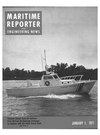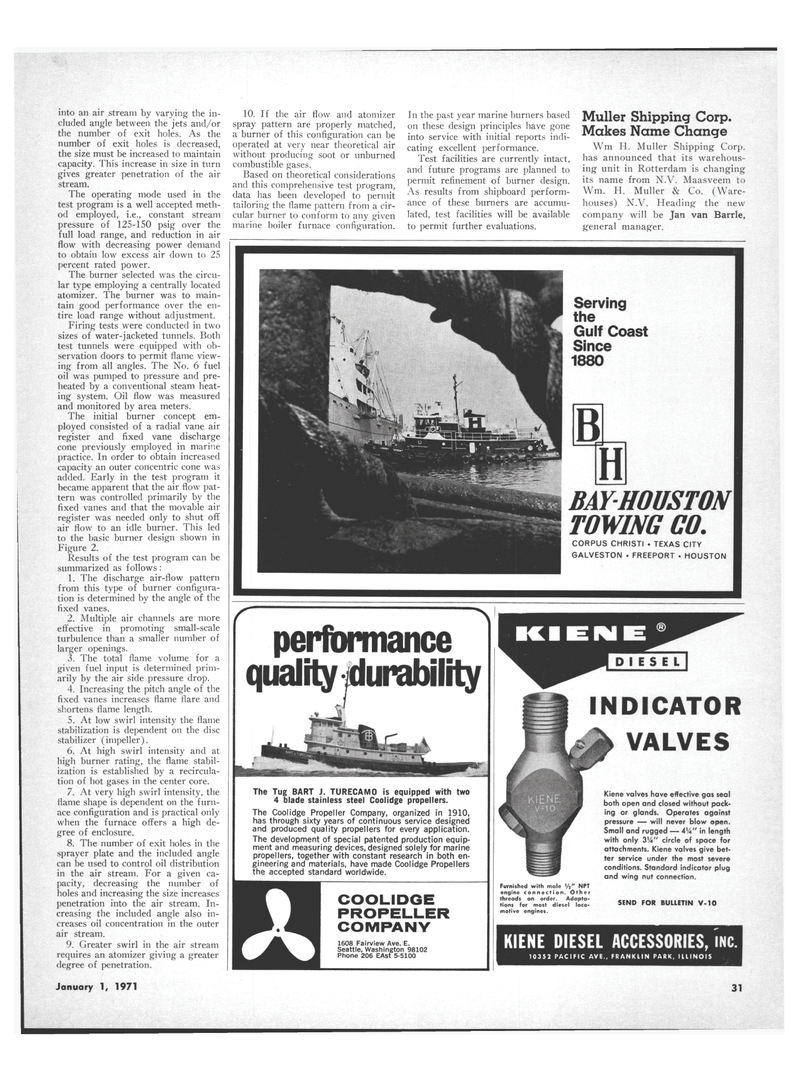
Page 29: of Maritime Reporter Magazine (January 1971)
Read this page in Pdf, Flash or Html5 edition of January 1971 Maritime Reporter Magazine
into an air stream by varying the in- cluded angle between the jets and/or the number of exit holes. As the number of exit holes is decreased, the size must be increased to maintain capacity. This increase in size in turn gives greater penetration of the air stream.
The operating mode used in the test program is a well accepted meth- od employed, i.e., constant stream pressure of 125-150 psig over the full load range, and reduction in air flow with decreasing power demand to obtain low excess air down to 25 percent rated power.
The burner selected was the circu- lar type employing a centrally located atomizer. The burner was to main- tain good performance over the en- tire load range without adjustment.
Firing tests were conducted in two sizes of water-jacketed tunnels. Both test tunnels were equipped with ob- servation doors to permit flame view- ing from all angles. The No. 6 fuel oil was pumped to pressure and pre- heated by a conventional steam heat- ing system. Oil flow was measured and monitored by area meters.
The initial burner concept em- ployed consisted of a radial vane air register and fixed vane discharge cone previously employed in marine practice. In order to obtain increased capacity an outer concentric cone was added. Early in the test program it became apparent that the air flow pat- tern was controlled primarily by the fixed vanes and that the movable air register was needed only to shut off air flow to an idle burner. This led to the basic burner design shown in
Figure 2.
Results of the test program can be summarized as follows: 1. The discharge air-flow pattern from this type of burner configura- tion is determined by the angle of the fixed vanes. 2. Multiple air channels are more effective in promoting small-scale turbulence than a smaller number of larger openings. 3. The total flame volume for a given fuel input is determined prim- arily by the air side pressure drop. 4. Increasing the pitch angle of the fixed vanes increases flame flare and shortens flame length. 5. At low swirl intensity the flame stabilization is dependent on the disc stabilizer (impeller). 6. At high swirl intensity and at high burner rating, the flame stabil- ization is established by a recircula- tion of hot gases in the center core. 7. At very high swirl intensity, the flame shape is dependent on the furn- ace configuration and is practical only when the furnace offers a high de- gree of enclosure. 8. The number of exit holes in the sprayer plate and the included angle can be used to control oil distribution in the air stream. For a given ca- pacity, decreasing the number of holes and increasing the size increases penetration into the air stream. In- creasing the included angle also in- creases oil concentration in the outer air stream. 9. Greater swirl in the air stream requires an atomizer giving a greater degree of penetration. 10. If the air flow and atomizer spray pattern are properly matched, a burner of this configuration can be operated at very near theoretical air without producing soot or unburned combustible gases.
Based on theoretical considerations and this comprehensive test program, data has been developed to permit tailoring the flame pattern from a cir- cular burner to conform to any given marine boiler furnace configuration.
In the past year marine burners based on these design principles have gone into service with initial reports indi- cating excellent performance.
Test facilities are currently intact, and future programs are planned to permit refinement of burner design.
As results from shipboard perform- ance of these burners are accumu- lated, test facilities will be available to permit further evaluations.
Muller Shipping Corp.
Makes Name Change
Wm H. Muller Shipping Corp. has announced that its warehous- ing unit in Rotterdam is changing its name from N.V. Maasveem to
Wm. H. Muller & Co. (Ware- houses) N.V. Heading the new company will be Jan van Barrle, general manager.
Serving the
Gulf Coast
Since 1880
EL H
BAY-HOUSTON
TOWING CO.
CORPUS CHRISTI . TEXAS CITY
GALVESTON . FREEPORT . HOUSTON performance quality idurability
The Tug BART J. TURECAMO is equipped with two 4 blade stainless steel Coolidge propellers.
The Coolidge Propeller Company, organized in 1910, has through sixty years of continuous service designed and produced quality propellers for every application.
The development of special patented production equip- ment and measuring devices, designed solely for marine propellers, together with constant research in both en- gineering and materials, have made Coolidge Propellers the accepted standard worldwide.
COOLIDGE
PROPELLER
COMPANY 1608 Fairview Ave. E.
Seattle, Washington 98102
Phone 206 EAst 5-5100
Furnished with male V2" NPT engine connection. Other threads on order. Adapta- tions for most diesel loco- motive engines.
INDICATOR
VALVES
Kiene valves have effective gas seal both open and closed without pack- ing or glands. Operates against pressure — will never blow open.
Small and rugged — 4V4" in length with only 3Vi" circle of space for attachments. Kiene valves give bet- ter service under the most severe conditions. Standard indicator plug and wing nut connection.
SEND FOR BULLETIN V-10
KIENE DIESEL ACCESSORIES, INC. 10352 PACIFIC AVE., FRANKLIN PARK, ILLINOIS
January 1, 1971 31

 28
28

 30
30
